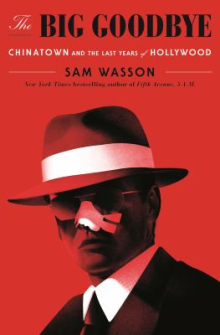
Sam Wasson, a Los Angeles writer specializing in film and theater, has written a book that examines the making of Roman Polanski’s film, Chinatown. This book stands as the most comprehensive examination of the film’s production, and will please cinephiles, as well as others. Wasson focuses on four men, who were pivotal to the development of the film: writer Robert Towne; producer Robert Evans; actor Jack Nicholson; and director Roman Polanski. Wasson contends that these four men shaped the creative and intellectual life of the film, constructing one of the most unforgettable films of all time. The book is a vibrant and absorbing account of the development, production, and aftermath of a movie that has been hailed as a masterpiece of American cinema and stands as the quintessential film about Los Angeles.
The book sketches a biographical timeline of the four men, highlighting how their creative interests and social lives intersected in the advancement of the film. Wasson shows that the creative processes and story developments were often negotiated between the players, with Polanski typically winning out over everyone. Wasson largely credits Polanski with the film’s artistic success and transforming what was essentially an average script into an unforgettable masterpiece that redefined the noir genre. In researching the film, Wasson interviewed many of the cast and crew members including Polanski and Evans, which gives their narratives a little more heft than his analysis of either Nicholson or Towne, neither of whom actually spoke with the author. In the case of Towne, Wasson spoke with Julie Payne, the daughter of actor John Payne and Towne’s ex-wife (girlfriend at the time Chinatown was written), and she provided some fascinating insights into the development of the story and screenplay that may be more invaluable and insightful than anything Towne might have been willing to contribute.
Polanski and Towne are the most compelling figures and were the primary creative entities behind the final film. Polanski’s personal history is a catalog of tragedies that read as operatic in scope. His work on Chinatown would also represent the first time he had returned to Los Angeles since the murder of his wife, Sharon Tate, and his reluctance was apparent. Tate’s murder had sent Polanski into a tailspin of suspicion and distrust resulting in a cynicism that would reveal itself throughout Chinatown. Coincidentally, we learn that it was Tate’s death that prompted Towne and girlfriend Payne to purchase a guard dog for protection, and the man who sold them the dog was an LAPD vice cop who had worked in the Chinatown area of Los Angeles. Towne inquired as to what the cop did while working in Chinatown, and his response sowed the seeds for an original story. In creating his screenplay, Towne wrestled with numerous scenarios and characters. Some of the ideas were interesting, while others fell flat and were best left on the cutting room floor, which for Chinatown enthusiasts is riveting to read about--some of those cut versions. The struggle between Towne and Polanski over the ending of the film seems to be a battle between dark and light, with Towne championing the happy ending he had envisioned, and Polanski believing that evil would triumph. In an ironic twist, Polanski’s cynicism probably earned Towne an Oscar for Best Original Screenplay, the film’s only Academy Award win.
In the book there is a glaring oversight about Faye Dunaway’s contribution to the film. Her presence accounts for significantly less print than that of supporting actor John Huston. All of this despite her co-star billing with Nicholson, and her masterful interpretation of an infinitely more complex character. The handful of acknowledgments she does merit are little more than passing mentions regarding her “difficulty” during production, including the now mythic battle with Polanski over a stray hair that he plucked from her head. Actors like James Hong share inherently positive memories of Dunaway that stand in stark contrast to stories about the woefully unprofessional behavior that Polanski was largely responsible for perpetuating. Given Polanski’s blotchy reputation with women, which has come under major scrutiny in the Me Too era, Dunaway’s participation in the film deserves a better examination.
Overall, the book is a real treat for Chinatown enthusiasts and movie nerds alike. It is extremely well researched and benefits from speaking with a wealth of participants, everyone from costume designer Anthea Sylbert to actor Jesse Vint, who had a small part as a farmer. Robert Evans and Julie Payne passed away since their interviews by Wasson, making the book even more unique and remarkable as a document recording the film’s history. Speaking as a die-hard Chinatown enthusiast, this book is sure to delight even the most grizzled fan and provides an exciting analysis of one of the greatest films of all time.
This book is available on e-media Sam Wasson has written some other books available on e-media.